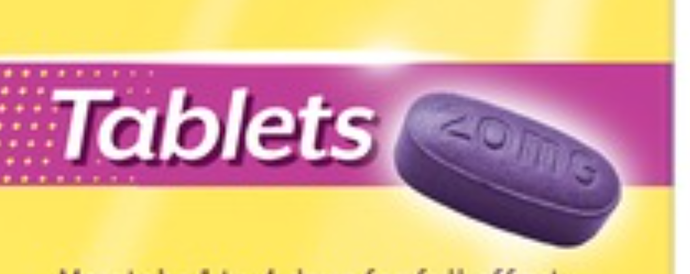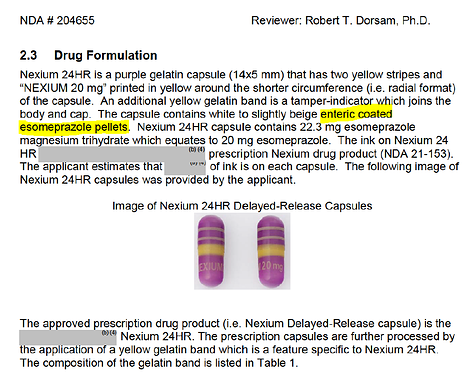The tablets were tiny. They don’t seem to have much of a coating on them. The packaging just says “delayed release tablet”.
Yes, the tablets are enteric coated and the package insert states “swallow whole. Do not crush or chew.”
Is there any benefit to using the tablets vs. capsules vs. clear minis?
I’m using the generic capsules from Walmart, but would pay extra for the Nexium brand clear minis if there was a benefit to using them.
Putting them right on top dead center, in the hopes that those first “scarfing” or “wolfing” bites of grain will go down the pipe mostly unchewed.
Nope. It’s whatever your horse will eat intact.
That’s what I’ve done, and suggest - that “hangry” bite seems more likely to just get swallowed
I have been really trying to read through this thread but unfortunately cannot, lol.
I have been steadily looking for a solution to help my anxious horse undersaddle. I thought it was about calming supplements, but really considering ulcers now. She is quite cranky grooming which she wasn’t always and had been worse, gets really grouchy and grinds her teeth when I put saddle on, and is just high strung under saddle. Doesn’t kick or buck or anything but just so very tense. She’s already on regumate. The one thing I never tried was ulcer tx.
It was brought to my attention the success nexium brings to many horses and I found this thread.
What is a typical starting dosage/treatment plan with nexium? Is it three capsules a day?
Would love to trial this as I’m seeing so many people having good outcomes with it.
Yes, three capsules. Basic info is really covered in the first couple pages here. Good luck!
Thanks! Very excited to try. Have been trying to read through the thread. I got the dosages down.
Just want to confirm it’s fine to throw on top of evening grain? I saw posts that it should be given on an empty stomach but also recent posts that capsules are thrown on top of PM feed. Any notable difference between throwing it with night feed versus alone in a small treat?
The goal is to maximize the changes the capsules/pills don’t get crunched. They are most likely to get crunched in a small treat
When I have used them, I put them right on top, in the middle, of a slight mound of feed, in hopes that the first hangry bite doesn’t get chewed as well, and tossing a few extra in helps in the situation where some get crunched, and definitely isn’t too much.
Going along with this, I also use the “mini” capsules exclusively. In them, the esomeprazole is in tiny little balls with a further coating. They are small pills anyway, but if they do get crunched, I feel like the esomeprazole has a better chance of making it through the stomach acid intact.
I tend to feed mine with a small handful of ration balancer pellets; the pills are roughly the same size and the horse doesn’t notice. I also watch very closely to ensure the pills don’t get dropped on the ground (as can happen with open-mouth chewers over their feed tub).
Unfortunately, that’s not an enteric coating, and the mini capsules still come with the warning to not open them. The only difference is the actual capsule size.
So assuming the OTC Nexium24 is the same as the Rx Nexium extended release capsule, the granules have an enteric coating.
The do not crush/chew statement is fairly standard wording for extended release medications. In the Rx labeling it says for patients who have difficulty swallowing you can open the capsule and sprinkle the granules on applesauce, but must be swallowed without chewing. (I’m guessing that’s not in the OTC label since if you can’t swallow you shouldn’t be taking Nexium without the direction of a Doctor.)
It is not.
This one tripped me up for awhile too. The package insert for Nexium 24 Hour is what you want to be looking at.
From my interpretation of the NDA for the Rx to OTC switch, they essentially take the 20mg Rx and apply the tamper band that is required for OTC capsules. 
If that’s the case, it certainly takes pressure off of getting the capsules down intact!
Adding my experience:
Horse presented with very mild possible ulcer symptoms late last year (started to get picky about eating concentrates but not hay, losing weight) and then got VERY spooky and anxious after having his stifle injected (bit of steroid and a couple days of stall rest seems to have put him over the edge).
I did a full month of generic omeprazole tubes (ours here have aloe and l-glutamine added), and weaned off appropriately.
He went several months seemingly happy, then started getting weird again - he has a very particular spooking behaviour that he uses to “tell me” he’s ulcery. I tried the Nexium protocol this time. Started off with 3 pills/day for a few days, then upped to 4 as he’s over 1200 lbs - the 4 pills really made a difference and he felt fantastic. Did 4 full weeks of full dose, then one week at 3 pills, one week at 2 pills, one week at 1 pill, then stopped (7 weeks total).
Only went a couple weeks before the weird spooking came back, plus getting picky about eating again, and looked tucked-up.
Put him back on Nexium while I waited for my vet appt to scope. Had the scope done today and he’s got mostly grade 1, with some grade 2.5, non-glandular ulcers. He’s now starting a round of real Gastrogard.
So, unsure if the Nexium helped somewhat but needed longer to really heal, or was just making him feel better while he was on it, but we didn’t have success with one round.
I do have some extra Nexium that I am planning to use as pre-show preventative once we’ve got the ulcers cleared up, and we’re planning to rescope after 28 days of Gastrogard so we can take advantage of their program of a free second round if there are still ulcers after treatment.
I thought I would add my experience, as I’m a bit confounded by it.
Horse presented with ulcery behavior in March 2022. Had vet out March 22nd. Due to unique boarding circumstances (boarding barn AM staff will not administer oral meds), decided to try Nexium instead of traditional GastroGuard paste, as the GG past could not be administered as is recommended.
Gave Nexium 4 capsules for 30 days (Mar 22 - Apr 22, did full taper. behaviors resolved, happy horse.
Mid-May 2022, behaviors returned. Scope scheduled for June 10th. Scope revealed Grade 3/Grade 4 ulcers  Vet and I reviewed options for treatment. Decided to try Nexium at higher dose (14 capsules per day) plus Misoprostol 2x per day.
Vet and I reviewed options for treatment. Decided to try Nexium at higher dose (14 capsules per day) plus Misoprostol 2x per day.
Rescope July 13th - Grade 3/Grade 4 ulcers. Very little/no healing.
At this point we are trying Injectable Omeprazole, Misoprostol 2x per day, plus Sucralfate 3x per day.
I am not sure why my horse is having such an atypical response to ulcer treatment. It’s not fun.
Where are the ulcers? We’ve had several threads about impossible/nearly impossible to heal ulcers in the pyloric or duodenal region of the stomach. These take a different medication regime, over a long course, to resolve.
Delayed gastric emptying syndrome can also cause very persistent gastric ulcers. (Interestingly, a high pH in the stomach can delay emptying, which makes me wonder if we’re seeing more of this because of frequent PPI treatment…  )
)
If your vet is perplexed, it might be worth getting in touch with a large referral center that sees more persistent ulcer cases.
Strangely enough, only Squamous ulcers. No Glandular Ulcers or Pyloric Ulcers (Thankfully!)
You would think that this would be easier to fix than it has been 
We’re giving the IM Omeprazole a shot, with misoprostol and sucralfate. And a change to a new boarding situation that can better support optimal ulcer care.







